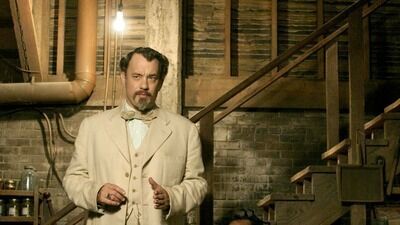It’s a feeling most deeply felt in the aching reveal shared by Navorski and Warren. “So what am I seeing,” Warren asks Navorski, having just learned that he is not a delayed business traveler but a man without a country. “Who are you,” she further prods, “Unacceptable?” As Navorski, Hanks is kinetic. He relies on swinging hand gestures, his head slightly bowed to suggest meekness. When Warren attempts to storm away, his long, exaggerated strides work to catch up to her. He leads her to the mosaic fountain he’s built for her, a nod to Napoleon’s gift to Josephine after conquering Bavaria. But the gesture is not enough. He must come out with the full truth. Spielberg opts for low-key lighting as Navorski—his hands clasped, his body slightly leaning forward—explains his mission to get these jazz signatures. Spielberg then cuts to a two shot of Warren on one side and Navorski on the other, back lit by the fountain. The shot accentuates their silhouettes, calling attention to Hanks’ explanatory hand gestures. A close-up sees Navorski, one by one, pulling out the signatures: Scribbled on photographs, coasters, and other club ephemera. Navorski stands up, moving closer to the fountain. “What are you waiting for,” asks Warren. “I’m waiting for you,” responds Navorski with such earnestness that Warren must kiss him.
For my money, the romantic pairing of Hanks and Jones doesn’t wholly work. Mostly because Warren is underwritten. But the surprising success of their lovestruck scene teases a lesson learned by Hanks. It’s not enough to perform mimicry, as he did in “The Ladykillers.” There needs to be an essence for the audience and the actor to latch onto. In this scene, he ceases to play Navorski the caricature. He plays Navorski the human.
Hanks continued to test the boundaries of impersonation in his third 2004 film: Robert Zemeckis’ unhinged nightmare fueled animated Christmas flick “The Polar Express.” Similar to “The Terminal,” “The Polar Express” once again witnessed Hanks reteaming with a director he previously had considerable success with. The actor and director’s first partnership, “Forrest Gump,” netted Hanks his second straight Best Actor Oscar; their second teaming, “Cast Away,” might be the actor’s best performance of his career. But a weird, ungodly concoction happened with their first foray into motion capturing (a technology Zemeckis would become slavishly addicted to on “Beowulf,” “A Christmas Carol,” and “Welcome to Marwen”). The results of which have continued to fuel online humor.
In “The Polar Express,” Hanks does voicework for six different characters. He is first heard in the opening scene as the adult narrator of this story looking back at his childhood. Known as Hero Boy, this is a kid whose belief in Santa is so diminished, he needs this fateful night to reignite his sense of wonder. Hanks also plays Hero Boy’s father, who laments his son’s disillusionment. As Hero Boy lies in his bed on Christmas Eve, awaiting the next day, the magical Polar Express pulls outside his house. Its conductor, also voiced by Hanks, punches the kid’s golden ticket to the North Pole. The journey to Santa’s workshop is filled with plenty of obstacles won over by Hero Boy’s pure spirit: He helps Hero Girl (Nona Gaye) with her ticket, gives a lonely kid (Peter Scolari) the courage to step aboard the locomotive, and even helps Santa with his sleigh.

